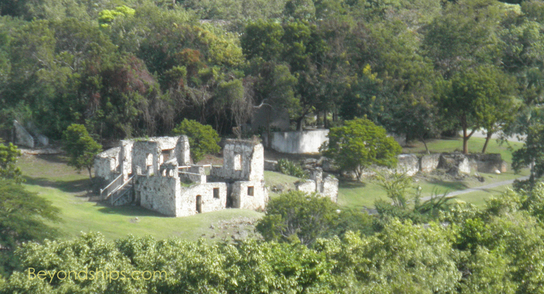|
St. John has been inhabited since prehistoric times. Indeed, significant prehistoric sites are present on almost every beach and in every bay within the national park. In particular, there are ongoing archaeological excavations at Cinnamon Bay unearthing remnants of the Taino people.
The Arawak Indians from South America had occupied the island by 300 A.D. But as happened throughout much of the Caribbean, they were displaced by the more war-like Carib Indians in about 1300. About two hundred years later, Christopher Columbus came across this chain of islands and named them the Eleven Thousand Virgins in honor of the feast day of St. Ursula and the 11,000 virgins that were martyred with her. European dominance of St. John began in earnest when the Danish West Indies Company came to the island in 1718. Nearly the entire island was cleared and converted to sugar plantations. To work on the plantations, thousands of Africans were brought to the island as slaves. In November 1733, a slave rebellion was begun by people from the Akwamu nation who had been sold into slavery when their nation was conquered by other African tribes. Interestingly, the purpose of the revolt was not to free all the slaves on St. John but rather to have the Akwamu displace the Danes as the owners of the plantations. The new owners would then continue in the sugar cane business using other Africans as slaves to work the plantations. The rebellion met with initial success and the Akwamu controlled the island for several months, even occupying the fort at Coral Bay. However, in April 1734, French troops from Martinique arrived and defeated the rebels. The Danes ended the slave trade in 1803. While this meant that no new slaves could be brought to the island, the slaves on the island were not freed. It was not until slaves on St. Croix held a mass non-violent demonstration in 1848 that the slaves were emancipated throughout the Danish West Indies. |
Without slave labor, the sugar plantations were no longer viable and fell to ruin. Consequently, most of the dense
vegetation one see today on the island is actually second generation vegetation that has grown up since the plantations were abandoned. In the years following the end of the plantations, the primary industry on St. John became subsistence farming and many people left the island. In the beginning years of the 20th Century, the population was less than 1,000. The United States purchased the Danish Virgin Islands in 1917 because of their strategic location in the Caribbean. It paid $25 million. Slowly word began to spread of this beautiful new American island and gradually St. John became a tourist destination. During a cruise ship call in 1952, venture capitalist and financier Laurence Rockefeller was struck by St. John's natural beauty. After building a resort at Caneel Bay, he purchased additional land in order to protect the island from further development. In 1956, he donated 5,000 acres to the United States government and the Virgin Islands National Park was born. Additional acreage was added in 1962 and 1978. In order to further protect the underwater beauty of the reefs off St. John, the Virgin Islands Coral Reef National Monument was created in January 2001. |
|
|
For more about cruising to St. John:
Click here for an overview of St. John Click here for information about getting to St. John Click for information on St. John beaches |
|
|
|
Cruise destination travel guide - St. John USVI - St. John history
